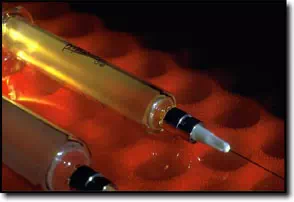 Colorado Colorado
Infectious Medical Waste
Definition of Infectious Medical Waste
Management of Infectious Medical Waste
OSHA Regulations
Statutes, Regulations and Guidelines
Contacts
Definition of Infectious Waste
In Colorado, infectious waste is defined
as any waste capable of producing an infectious disease in a susceptible
person. Generally recognized infectious wastes include, but are not
limited to: isolation wastes from persons having a disease requiring
Biosafety Level IV containment; cultures and stocks of infectious agents
and biologicals; human blood, blood products and other body fluids;
human pathological or anatomical waste consisting of tissues and body
parts; contaminated sharps; and contaminated research animals and bedding.
Managing
Regulated Medical Waste
Management Plan. Healthcare facilities
that generate infectious waste must develop and implement an on-site
infectious waste management plan appropriate for their particular facility.
This plan must be available to the hauler of the waste, to the disposal
facility, and to the licensing or regulatory agency. The plan must
include the designation of infectious waste, provisions for the handling
of that waste, staff training, contingency planning for spills or loss
of containment, the designation of a person responsible for implementation
of the plan, and provisions for appropriate on and off-site treatment
or final disposal.
Packaging and Labeling. Receptacles
containing infectious waste must be clearly labeled with the biohazard
symbol or with the words "Infectious Waste" in letters at least one
inch high. Untreated waste must be stored, packaged, contained, and
transported in a manner that prevents the release of the waste material
and in a manner to prevent nuisance conditions. Contaminated sharps
(needles, syringes, lancets) must be placed in a puncture resistant
container and be properly designated as untreated infectious waste
or made noninfectious by an appropriate treatment method. Untreated
containers of sharps cannot be compacted.
Storage. There are no storage
time limits for generators of infectious waste. The waste need only
be stored in a manner to prevent release of the waste and to prevent
nuisance conditions.
Off-Site Disposal in a Landfill. Properly
labeled and packaged infectious waste may be disposed of in a permitted
solid waste disposal facility without treatment. Landfills must be
approved by their local governing authority and the state health department
to accept this type of waste. If untreated infectious waste is disposed
of in a solid waste disposal facility, these procedures must be documented
in the generator's waste handling plan and must be acceptable to the
waste hauler and disposal site. Recognizable human anatomical remains
cannot be disposed of at a solid waste landfill. These must be either
incinerated or interred.
Other Treatment/Disposal Options. Veterinary
facilities may treat their infectious waste themselves to render it
noninfectious or contract with a medical waste disposal company. Infectious
waste that has been appropriately treated to render it non-infectious
is no longer considered infectious for handling and disposal purposes. Treated
waste can be disposed of with other noninfectious and nonhazardous
solid wastes after the generator either identifies it as appropriately
treated waste or provides the hauler and disposal facility with a written
statement that its general waste includes appropriately treated infectious
waste. Appropriate treatment is any method that renders the waste
noninfectious, and must include the following: documentation that the
method is effective; a written standard operating procedure for implementation
of the method; and regular monitoring to test the effectiveness of
the treatment. Widely used treatment methods include incineration,
autoclaving, decontamination, and sterilization.
The Colorado Department of Public Health
and Environment does not approve or recommend specific treatment methods,
but leaves it up to the generator to determine what is an appropriate
and effective treatment method for their wastes.
OSHA
Regulations
In addition to the state medical waste
environmental regulations there are some Occupational Safety and Health
Administration (OSHA) rules that apply to medical/infectious waste. Colorado
is one of 26 states covered entirely by the federal OSHA program. This
program is operated by the Occupational Safety and Health Administration. OSHA
rules (Occupational Exposure to Bloodborne Pathogens Standards) impact
various aspects of medical/infectious waste, including management of
sharps, requirements for containers that hold or store medical/infectious
waste, labeling of medical/infectious waste bags/containers, and employee
training. These requirements can be found in the VetCA section entitled OSHA Standards for Regulated Waste.
Statutes,
Regulations and Guidelines
State
Board of Health Regulations pertaining to Solid Waste Sites and Facilities
6 CCR 1007-2, Part 1
Compliance Bulletin Solid Waste Infectious Waste Management
Contacts
Colorado Department of Public
Health and the Environment
Colorado Department of Public
Health and the Environment--Hazardous Material and Waste Management
Division
More Information
None located. |

